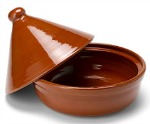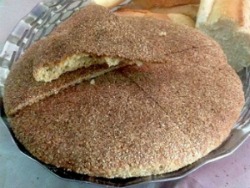This Moroccan Lamb Tagine with Sesame Prunes dish is a traditional Moroccan tagine recipe (the dish is named for the cookware) which typically includes a combination of braised meat (often lamb, beef or chicken), fruits, root vegetables, and fragrant spices like cinnamon, saffron, and ginger).
This dish is often served at holiday gatherings, weddings, and other special occasions with Mahrash Moroccan Bread for scooping up the meat and sauce. The prunes in the dish soak up the fragrant spices, and long, slow cooking makes for fork-tender lamb. It can also be made the day before an event and re-heated just before the party.
Read about our interesting trip to Tangier, Morocco.
 What is a Tagine: Tagines are a traditional Moroccan clay or ceramic cooking pot that is used to make fragrant stews of the same name. They are designed according to ancient slow-cooking principles. The pot works like a pressure cooker, with warm air circulating around the conical lid and condensation returning to the dish below. The tagine is not only the cookware but is also the serving dish and it keeps the food warm. Traditionally tagines are eaten communally by the diners who gather around and eat by hand, using pieces of Moroccan bread as their eating utensil.
What is a Tagine: Tagines are a traditional Moroccan clay or ceramic cooking pot that is used to make fragrant stews of the same name. They are designed according to ancient slow-cooking principles. The pot works like a pressure cooker, with warm air circulating around the conical lid and condensation returning to the dish below. The tagine is not only the cookware but is also the serving dish and it keeps the food warm. Traditionally tagines are eaten communally by the diners who gather around and eat by hand, using pieces of Moroccan bread as their eating utensil.
How to Season a Tagine: Before a new tagine can be used, it must be strengthened to withstand cooking by seasoning it. Seasoning the tagine strengthens the tagine and infuses it with flavor. Using olive oil is the traditional Moroccan method for the sealing the clay and obtaining the best flavor for your food.
A new tagine needs to be submerged in water for at least 1 hour. You can use your clean kitchen sink and slowly fill the base of the tagine with water until it stops absorbing it. Place the tagine lid on top and fill it as well. Let stand for 30 minutes to allow full absorption of water into the clay. Empty excess water and set to dry for 5 minutes.
Use a total of three (3) tablespoons of olive oil, 2 tablespoons for the base and one for the lid. Spread the olive oil throughout the inner cooking surfaces of the base and lid with your hands. After spreading the oil over the tagine and while it is still wet from the oil, place it in the oven. Set the base down on the rack, and the cone next to it with the wide end of the cone facing upwards. Set the temperature at 350 degree F. and leave in the oven for 45 minutes. The evaporation of moisture creates a vacuum effect to pull the olive oil into the clay which glazes and seals it. Turn the oven off, place the cone lid on the tagine tray and leave the tagine to cool down in the turned off oven.
Care of Tagine Pots: To keep your tagine in best condition and avoiding damage, try to not expose the tagine to extreme temperature variances.
Do not add cold liquids to a hot tagine and do not set a cold tagine on a hot surface. Do not put your tagine in a dishwasher or submerge it in soapy water. To clean a tagine, use hot water and baking soda. Avoid using soap, if possible, as the clay can absorb the soap and cause your food to taste soapy. If you do need to use soap, use a mild one and rinse the tagine immediately and extra well. Pat the tagine to dry, and rub the inner surfaces with olive oil before storing.
If your tagine becomes scorched, you can try filling the tagine half way with water and two tablespoons of baking soda, let simmer on medium-low heat for a half hour, then try loosening the scorched area. If it is a difficult scorch, remove the tagine from the heat and let it set over night in the baking soda mix and try loosening the scorch the next day.
Tips for Cooking with a Tagine: To cook with a ceramic or clay tagine, use only as much heat necessary to maintain a simmer. To avoid damaging the tagine or scorching the food, never cook above a low to medium low heat.
If you use a tagine on an electric stove, it is important to use a heat diffuser. A heat diffuser is a stove top utensil which ensures that heat is evenly distributed across the bottom of a pan. This is crucial for dishes which need to simmer for a long time on low settings, and it can eliminate the common problem of burned or unevenly cooked food.
Tagines are also used over a small fire or over charcoal although it is more difficult to maintain the correct temperature this way. You can also use the clay or ceramic tagine in the oven by placing the cold tagine in a cold oven on a rack, and then set the oven at no more than 325 degrees F.
Oil is essential to tagine cooking; in most recipes for 4 to 6 people, you will need between 1/4 to 1/3 cup of oil (sometimes part butter). Use olive oil for the best flavor. Using a tagine requires you to use less water when cooking because the cone-shaped top condenses steam and returns it to the dish. If you added too much liquid, it can take a while to reduce in a tagine. You can carefully remove the excess liquid and use a small pan to further reduce it, and then return it to the tagine once it thickens. When cooking let the tagine reach a simmer slowly. Poultry takes about two hours to cook while beef or lamb may take up to four hours.
Avoid lifting the lid to check the food or add ingredients until the end of the cooking process . When you lift the lid, it will cause the cooking process to stop and the heat will need to build up in the tagine again in order for it to start again.
Sources:
How To Cure A Tagine, Tagine Cooking and Moroccan Living.
How Do You Use a Tagine – Tips for Cooking in a Tagine
- 4 tablespoons olive oil
- 1 onion, sliced
- 2 pounds boneless leg of lamb, lean, cut into 3-inch pieces
- 3 cloves garlic, chopped or minced
- Salt and freshly-ground black pepper
- 1/2 teaspoon coriander, ground
- 1 cinnamon stick
- 1/2 teaspoon cumin, ground
- 1 teaspoon ginger, ground
- Pinch of saffron threads, soaked in 1 tablespoon water
- 2 1/2 cups water, hot
- 12 large unpitted prunes, dried, soaked in warm water
- 1/2 cup of reserved liquid from tagine
- 4 tablespoons honey
- 1/2 teaspoon cinnamon, ground
- 1 teaspoon sesame seeds, toasted
- 1 egg, hard-cooked
- 1 teaspoon sesame seeds, toasted
-
Heat the Tagine on a diffuser over medium heat on your stove top with 3 tablespoons olive oil. Add the sliced onions by layering the onion rings on the bottom of the Tagine.
-
In a bowl, mix together the lamb pieces with garlic, remaining 1 tablespoon of olive oil, and ground coriander, cinnamon stick, ground cumin, ground ginger, and soaked saffron threads; place this mixture on top of the onion rings.
-
Add 2 1/2 cups hot water, cover with Tangine lid and let cook until the Tagine reaches a simmer (this may take a long time).
-
Cook the Dried Prunes while the dish in cooking (see recipe below).
-
Once the Tagine reaches a simmer, reduce the heat to the lowest temperature necessary to maintain the simmer. Allow the tagine to cook for at least 3 hours or longer, until the meat is very tender and the liquids are reduced. About 2 hours into the cooking, remove and reserve 1/2 cup of the liquids for the cooked prunes. Once the Tagine is done cooking, add the cooked prunes (see below) and leave to simmer for an additional 20 minutes.
-
 This Tagine dish can also be made the day before an event and re-heated just before the party.
This Tagine dish can also be made the day before an event and re-heated just before the party. -
Serve in the Tagine cooking pot. Peel and add the hard boiled egg, sprinkle toasted sesame seeds over prunes, and serve hot. Serve with Mahrash Moroccan Bread.
-
Makes 15 servings.
-
While the meat is cooking, put the prunes in a small pot and cover with water. Simmer over medium heat, partially covered, until the prunes are tender about 15 to 30 minutes depending on the size of the prunes.
-
Remove from the stove and drain the prunes. Stir in the 1/2 cup of liquids reserved from the meat.
-
Stir in the honey and cinnamon and let simmer the an addition 10 minutes or until they are sitting in a thick syrup.
-
Remove from heat.


 This Tagine dish can also be made the day before an event and re-heated just before the party.
This Tagine dish can also be made the day before an event and re-heated just before the party.